List of heads of state of Marirana
| President of the Federative Republic of Marirana | |
|---|---|
| Presidente della Repubblica Federativa d'Marirano | |
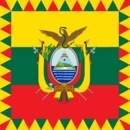 Presidential Standard | |
| Style | The Most Excellent |
| Residence | Presidential Palace |
| Term length | Five years, non-renewable |
| Inaugural holder | Romano Michelozzi First President of the Federative Republic of Marirana under the constitution of 1992 Onofrio Moretti First individual named President under the constitution of 1760 |
| Formation | first: 1760 Constitution current: 1992 Constitution |
| Salary | $260,000 annually |
| Website | Office of the President |
The Federative Republic of Marirana in its history has had various heads of state under different regimes in its history. Since the declaration of an independent Marirana in the 1719 there has been 45 heads of state of Marirana, of which 1 was a monarch, 34 constitutionally elected presidents, 3 military dictators and 7 interim leaders with the country being ruled by a military occupation as well and having 3 de facto head of states. Since 1994 Mariranan heads of state have governed as republican presidents under the 1992 constitution.
The pre-colonial Marirana was governed by petty kingdoms and tribes, with the largest being the Oaexicun Empire. Under colonial rule Marirana was officially ruled by the Archbishop of Aquinas who was appointed by the Solarian Catholic Church. The independence of Marirana was successful as loyalists and nationalists agreed to create a federal republic under a dictator elected by parliament with the first dictator being Cosimo Leopolda. In 1860 reformists changed the constitution changing the title to president, limiting presidents for a single five year term in office which was changed in 1790 to allow for re-election. In 1811 in a coup d'état radicals under Salvatore Moretti took power transforming the presidency into a dictator under a centralised state. The Mariranan-Roessen rule saw Marirana become a Grand Duchy in 1827.
In 1846 the Centralist Republic of Marirana was created with a strong presidency - between 1852-1870 Marirana was governed as a “presidential dictatorship”, returning to a constitutional republic in 1870. In 1905 the election of Ottaviano Castello saw the creation of the Sotirian State of Marirana and the replacement of the presidency with the position of Il Duce which was a personalist, right-wing dictatorship.
The Asterian occupation following the Great War saw Marirana transformed into a representative democracy with a liberalised economy, with presidents being able to be elected to a single five year term as was the case under the First Federative Republic. In 1972 the Fourth Federative Republic was dissolved and replaced by a civic-military dictatorship which saw the post of president become a figurehead, with real power being held by the head of the Standing Committee of Armed Forces Command, a military junta. In 1986 the dictatorship collapsed but the 1973 constitution remained in place until 1992, with the first president being elected under the 1992 constitution being Romano Michelozzi. The current president is Lorenzo Occhetto first elected in 2018.
Key
Military and non-partisan
Anti-republican right
Republican right
Republican centre
Republican left
Kingdom of Marirana (1715-1728)
| No. | Name | Reign start | Reign end | House | Marriage(s) Issue | ||
|---|---|---|---|---|---|---|---|
| 1 |  Abigail Pereramon (1710-1773) |
12 July 1715 |
5 March 1728 |
Pereramon | |||
| TBA. | |||||||
Grand Duchy of Marirana (1728-1786)
| No. | Name | Reign start | Reign end | House | Marriage(s) Issue | ||
|---|---|---|---|---|---|---|---|
| 2 | TBA | 12 July 1719 |
4 October 1736 |
Della Rovere | TBA | ||
| TBA. | |||||||
| 3 |  Adriano Augusto I (1710-1773) |
4 October 1736 |
13 May 1773 |
Della Rovere | TBA | ||
| TBA. | |||||||
| 4 |  Adriano Augusto II (1710-1773) |
13 May 1773 |
26 May 1786 |
Della Rovere | TBA | ||
| TBA. | |||||||
First Republic (1786-1787)
| No | Picture | Name | Term | Tenure | Presidential mandate | Affiliation | |
|---|---|---|---|---|---|---|---|
| 1 | 
|
Onofrio Moretti (1728-1771) |
1 | 26 May 1786 |
26 June 1786 |
May 1786 | Moderate Republican |
| Leader of the 26 May Revolution, Moretti launched several liberal reforms such as the abolition of slavery and the creation of a new constitution. The new presidency restricted term limits to a single month, leading Moretti to step down in June albeit he continued to exercise de facto control until the fall of the republic in December. | |||||||
| 2 | 
|
General Guido Causin (1736–1804) |
2 | 26 June 1786 |
26 July 1786 |
June 1786 | Moderate Republican |
| Causin largely continued his predecessors policies whilst clamping down on political dissent and attempting to secure foreign recognition. | |||||||
| 3 | 
|
General Paolo Francetti (1733-1792) |
3 | 26 July 1786 |
26 August 1786 |
July 1786 | Moderate Republican |
| Considered a glutton and ineffective president, Francetti left office as Etruria started its invasion of Marirana. | |||||||
| 4 | 
|
General Vito Bianco (1738-1803) |
4 | 26 August 1786 |
26 September 1786 |
August 1786 | Moderate Republican |
| Bianco was in 1777 forced to default on Marirana's debt due to his predecessor's excesses. His presidency was marred by instability and political polarisation by the time he left office in September. | |||||||
| 5 | 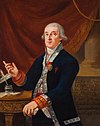
|
General Ettore Amato (1730-1788) |
5 | 26 September 1786 |
13 October 1786 |
October 1786 | Moderate Republican |
| Amato failed to placate the increasingly conservative army as radical Riformisti declined to support his government. Prior to the end of his term he was ousted in a coup d'état by conservative elements of the army during the Etrurian invasion of Marirana. | |||||||
| 6 | 
|
General Carlo Torelli (1742-1799) |
- | 13 October 1786 |
8 February 1787 |
Interim president | Restaurazionisti |
| Coming to power in a coup d'état, Torelli was supported by the monarchist Restaurazionisti. He accepted the invading Etrurian forces in 1786 and continued in an interim capacity until 1787. | |||||||
Second Kingdom of Marirana (1787-1796)
| No. | Name | Reign start | Reign end | House | Marriage(s) Issue | ||
|---|---|---|---|---|---|---|---|
| 5 |  Cosimo (1794-1868) |
8 February 1787 |
17 March 1796 |
di Francesco | TBA | ||
| The first and only Grand Duke of Marirana, Cosimo was supported by both the church and landowners. Strengthening the central government Cosimo's centralising reforms led to greater state revenue allowing Marirana to significantly reduce its debt and modernise the military. However discontent with his rule soon emerged and in 1796 he was deposed from power by the Army of the North setting off the Mariranan civil war. | |||||||
Second Republic (1796-1827)
| No | Picture | Name | Term | Tenure | Presidential mandate | Affiliation | |
|---|---|---|---|---|---|---|---|
| 7 | 
|
General Luciano Rosato (1745-1812) |
- | 17 March 1796 |
7 December 1796 |
Interim president | Moderate Republican |
| The leader of the Army of the North during the first phase of the Mariranan civil war, Rosato was considered to be the main figure behind the alliance of more radical republican and former monarchist officers. He was killed in 1796 leading to an alliance of moderate republicans and monarchists known as the Opportunist Republican to restart the civil war. | |||||||
| 8 | 
|
General Giuseppe Bartolozzi (1748-1811) |
- | 7 December 1796 |
14 March 1797 |
Interim president | Radical Republican |
| 6 | 14 March 1797 |
27 June 1798 |
1797 — 100% | ||||
| The leader of the radical republicans, Bartolozzi continued the civil war attempted to implement reforms that are anti-clerical and nationalist in nature. He was forced into exile in 1798 when ousted by his subordinate Salvatore Renzi. | |||||||
| 9 | 
|
General Salvatore Renzi (1748-1811) |
- | 27 June 1798 |
4 December 1798 |
Interim president | Radical Republican |
| Coming to power in a coup d'état, Renzi attempted to create an enlightened dictatorship based on anti-clerical regime on radical principles. However military incomeptence led to him to lose the Battle of Santa Maria which deposed him as president by Opportunist Republican forces. | |||||||
| 10 | 
|
General Maurizio la Russa (1748-1811) |
- | 4 December 1798 |
7 May 1799 |
Interim president | Opportunist Republican |
| 7 | 7 May 1799 |
27 June 1804 |
1799 — 100% | ||||
| 8 | 27 June 1804 |
14 October 1807 |
1804 — 100% | ||||
| La Russa came to power after seizing Santa Maria in 1798, being formally elected president in 1799. A conservative, la Russa nevertheless was a republican and disappointed monarchists when he refused to restore the monarchy championing a republican constitution. La Russa focused on combating the radical republicans who still occupied most of the east of the country as well as unsuccessfully renegotiate Marirana's debt issues. In 1807 he died in office ending his presidency | |||||||
| 11 | 
|
General Sergio Violante (1748-1811) |
- | 14 October 1807 |
27 June 1808 |
Interim president | Opportunist Republican |
| A general within la Russa's army, Violante seized power following his death. A monarchist Violante unsuccessfully attempted to invite the former Emperor Cosimo to return to Marirana, but was overruled by his subordinates triggering his resignation. | |||||||
| 12 | 
|
General Renato Melucci (1748-1811) |
- | 27 June 1808 |
23 September 1809 |
Interim president | Opportunist Republican |
| 9 | 23 September 1809 |
6 June 1811 |
1799 — 100% | ||||
| A conservative republican Melucci failed to appease anti-clerical forces that demanded the removal of clerical influence in Mariranan politics. Continuing the civil war he was unable to effectively defeat radical republican armies under Salvatore Renzi and in 1811 was ousted from power. | |||||||
| (9) | 
|
Generalissimo Salvatore Renzi (1761-1838) |
- | 6 June 1811 |
5 April 1814 |
Interim president | Radical Republican |
| 10 | 5 April 1814 |
5 April 1819 |
1814 — 99.53% | ||||
| 11 | 5 April 1819 |
5 April 1824 |
1819 — 99.53% | ||||
| 12 | 5 April 1824 |
17 June 1827 |
1824 — 99.53% | ||||
| Took power in a coup d'état, Renzi dissolved congress and started a "reign of terror" suppressing monarchist reactionaries, moderate republicans, the clergy and other "counter-revolutionaries" to consolidate the revolution. In 1823 he won the presidential election that year as the only candidate, and generally had strong support from the left-wing bourgeoisie and the peasantry for his revolutionary, proto-socialist and anti-clerical policies. In 1827 he came into conflict with Eldmark fleeing Marirana as Eldmark occupied the country. | |||||||
| 13 | 
|
General Francesco d'Avalos (1770-1827) |
- | 17 June 1827 |
22 September 1827† |
Interim president | Radical Republican |
| Renzi's vice-president, d'Avalos attempted to hold back Eldmarkish forces before being killed in the Battle of San Marco. | |||||||
Third Kingdom of Marirana (1827-1846)
| No. | Name | Reign start | Reign end | House | Marriage(s) Issue | ||
|---|---|---|---|---|---|---|---|
| 6 |  Federico (1794-1868) |
4th October 1827 | 6th June 1840 | tba | TBA | ||
| Crowned King with Eldmarkish backing in 1827, Fredrick (known as Federico in Marirana) was seen as a puppet of Eldmarkish forces allowing them unprecedented influence Mariranan affairs. Over time his government became increasingly unpopular as revolts occurred within the nation. He died of malaria in 180. | |||||||
| 7 |  Caterina (1794-1868) |
6th June 1840. | 13th April 1848 | tba | TBA | ||
| Caterina was Frederico's wife and the only eligible heir to the throne after his early death. Her government lacked support from the Mariranan oligarchy and she was overthrown in a coup d'état. | |||||||
Third Republic (1848-1861)
| No | Picture | Name | Term | Tenure | Presidential mandate | Affiliation | |
|---|---|---|---|---|---|---|---|
| 14 | 
|
General Bernando Tonduzzi (1793-1869) |
13 | 13 April 1848 |
1 May 1853 |
1848 — 44.3% | Liberal Party |
| Launching a coup against the monarchy with the support of republican politicians, Tonduzzi liberal policies relating to the church were implemented. However increasingly over time Tonduzzi faced opposition from conservative landowners as well as continued tensions with Eldmark. | |||||||
| 15 | 
|
General Riccardo Fisichella (1820-1894) |
14 | 1 May 1853 |
1 May 1858 |
1853 — 39.7% | Liberal Party |
| Fisichella's term coincided with economic growth increasing due to fiscal discipline. Fisichella departed from his predecessors by supporting free trade and attempting to decentralise government. | |||||||
| 16 | 
|
General officer Pellegrino Sant'Agata (1818-1897) |
15 | 1 May 1858 |
17 March 1861 |
1858 — 39.7% | Liberal Party |
| Sant'Agata to promoted policies such as liberalising the press and pushing for more expansive industrialisation. His anti-clerical law passed in 1861 resulted in the conservative elements of the military to successfully overthrow his government. | |||||||
Fourth Republic (1861-1884)
| No | Picture | Name | Term | Tenure | Presidential mandate | Affiliation | |
|---|---|---|---|---|---|---|---|
| 17 | 
|
Field Marshal Italo Agostino Saragat (1801-1870) |
- | 17 March 1861 |
6 June 1862 |
Interim president | Conservative Party |
| 16 | 6 June 1862 |
6 June 1867 |
1852 — 39.7% | ||||
| Saragat led the 1862 coup. Under his rule, Marirana became a unitary, conservative Catholic state. Although limited to a single term presidency, Saragat would act as the most powerful man in Marirana until his death in 1878. | |||||||
| 18 | 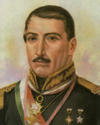
|
General Giacomo Scialoja (1796-1864) |
17 | 6 June 1867 |
6 June 1872 |
1857 — 39.7% | Conservative Party |
| Elected in 1857, Scialoja was regarded as a puppet of Saragat. Under his presidency Marirana's debt issues lessened whilst better relations with Nuxica were promoted. | |||||||
| (17) | 
|
Field Marshal Italo Agostino Saragat (1801-1870) |
18 | 6 June 1872 |
6 June 1877 |
1862 — 39.7% | Conservative Party |
| Returning to the presidency in 1857, Saragat would come to dominate Mariranan politics until his death in 1870. Under his second term there was significant economic development and administrative reform - however repression against political opponents started with the government becoming a "presidential dictatorship" as the free press was dismantled. | |||||||
| 19 | 
|
General Fortunato Pacifico (1835-1889) |
19 | 6 June 1877 |
6 June 1882 |
1877 — 39.7% | Conservative Party |
| Under Pacifico moderate industrialisation was pursued whilst immigration laws were liberalised in order to encourage population growth. Saragat's death in 1878 led Pacifico to undertake some reforms notably in foreign policy concluding an agreement with Vilcasuamanas in the form of the Aquinas Treaty of Defensive Alliance. | |||||||
| 20 | 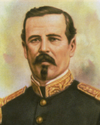
|
General Buscarello d'Ormea (1829-1894) |
20 | 6 June 1882 |
27 August 1884 |
1882 — 39.7% | Conservative Party |
| Under d'Ormea Marirana fought the War of the Arucian that led to the defeat of Mariranan forces. As a result of the defeat d'Ormea was ousted from power and replaced with a liberal government under general Joaquim Durão de Azevedo. | |||||||
Fifth Republic (1884-1905)
| No | Picture | Name | Term | Tenure | Presidential mandate | Affiliation | |
|---|---|---|---|---|---|---|---|
| 21 | 
|
General Joaquim Durão de Azevedo (1820-1894) |
- | 27 August 1884 |
15 March 1885 |
Interim president | Liberal Party |
| 21 | 15 March 1885 |
15 March 1890 |
1885 — 62.3% | ||||
| de Azevedo, a general of Floren descent, was the leader of the 1884 coup that deposed the conservative party. With strong backing from the liberal bourgeoisie and the peasantry and facing opposition from the clergy and military, de Azevedo built a strong alliance with coffee merchants in southern Marirana leading to his presidency to be the start of the so-called "aristocratic republic". de Azevedo supported classical liberalism and free trade as well as secular reforms to the church and several liberal reforms. | |||||||
| 22 | 
|
General Francesco Luzzatti (1838-1914) |
22 | 15 March 1890 |
15 March 1895 |
1890 — 62.4% | Liberal Party |
| Elected in 1890, Luzzatti supported the same principles of free trade as his predecessor. Under his administration Marirana acquired an unprecedented level of foreign debt albeit a large degree of political stability. | |||||||
| 24 | 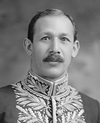
|
General Luigi Balsamo (1850-1901) |
23 | 15 March 1895 |
27 May 1897 |
1895 — 64.3% | Liberal Party |
| Elected in a divided electoral college, Balsamo took power as political stability started to collapse with industrial action, conflicts between left and right groups and a divided parliament leading to the collapse of the Liberal Party. He was assassinated by a political opponent in 1897. | |||||||
| 24 | 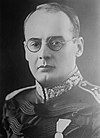
|
General Serafino Minuto-Rizzo (1849-1908) |
- | 17 August 1897 |
15 March 1900 |
Interim president | Liberal Party |
| Minuto-Rizzo was appointed as an interim president following Balsamo's assassination. His government was neither able to control peasant unrest on the left and military agitation from the right. | |||||||
| 25 | 
|
General Giovanni Lombardi (1850-1918) |
24 | 27 May 1900 |
20 February 1905 |
1900 — 77.6% | Liberal Party |
| Lombardi took power after the rigged 1900 election. Lombardi had no support within the military resulting in him appointing members of the conservatives to his cabinet, weakening liberal hegemony. Red December - a sustained period of left wing action in 1904 - led to Lombardi to impose a state of emergency and rule by decree with the aid of Ottaviano Castello, who would force himself into office following the 1905 election. | |||||||
| 26 | 
|
General Ettore Carozza (1850-1918) |
25 | Never took office | 1905 — 60.53% | Liberal Party | |
| Winning the 1905 election, Carozza was never inaugurated as president with military officer Ottaviano Castello ousting the liberal government before Carozza could take office. He is however legally recognised as a constitutional president by the Mariranan government. | |||||||
Sotirian State of Marirana (1905-1936)
| No | Picture | Name | Term | Tenure | Presidential mandate | Affiliation | |
|---|---|---|---|---|---|---|---|
| 27 | 
|
Generalissimo Ottaviano Castello (1859-1940) |
- | 20 February 1905 |
24 May 1910 |
Unconstitutional term | Integrated Union of the Traditionalist Right |
| 26 | 24 May 1910 |
17 June 1915 |
1910 — 99.5% | ||||
| 27 | 17 June 1915 |
13 June 1920 |
1915 — 99.9% | ||||
| 28 | 13 June 1920 |
26 June 1925 |
1920 — 99.7% | ||||
| 29 | 26 June 1925 |
24 June 1930 |
1925 — 99.5% | ||||
| 30 | 24 June 1930 |
1 March 1936 |
1930 — 99.3% | ||||
| Elected in 1905 with the backing of right-wing parties, Castello subsequently dissolved congress, creating a one-party state under the Integrated Union of the Traditionalist Right (UIdDT). Hostile to liberalism, democracy, socialism and communism Castello's regime was authoritarian, corporatist and Catholic. Although far-right and possessing several features reminiscent of National Functionalism Castello's reactionary politics mean his regime was more in line with a traditionalist, authoritarian form of conservatism. Upon coming to power, Castello launched the White Terror which saw 500,000 suspect communists and leftist agitators killed by Castello's regime. Castello began to create a centralised, military dictatorship as well as a cult of personality. Economically Castello launched a policy of autarkey and corpratisation based on the ideas of national syndicalism. Although in the short term an economic disaster, autarkey meant that Marirana was isolated from the Great Depression resulting in Castello to begin a programme of military Keynesianism. In the Great War Castello supported Gaullica and alongside Satucin invaded both Federation of Asteria and Roeselle. However, Castello's regime lost the war causing the Generalissimo to flee the country. | |||||||
| 28 | 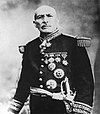
|
Field Marshal Enzo Sanmartino (1863-1942) |
- | 1 March 1936 |
18 March 1936 |
Interim president | Integrated Union of the Traditionalist Right |
| Castello's deputy, Sanmartino officially signed the surrender of Marirana as Asterian and Roessen troops occupied the country. On the 18th March Sanmartino officially dissolved the Sotirian State. | |||||||
Occupation (1934-1940)
Sixth Republic (1940-1963)
| No | Picture | Name | Term | Tenure | Presidential mandate | Affiliation | |
|---|---|---|---|---|---|---|---|
| 29 | 
|
Antonio Michelozzi (1899-1982) |
31 | 24 August 1940 |
17 August 1946 |
1940 - 46.5% | Rally for the Republic |
| The first civilian president in Mariranan history, Michelozzi ran on a reformist platform. His government mainly focused on democratisation and economic reconstruction. Under Michelozzi mild social reforms implemented, trade unions were supported, anti-clerical laws passed and the initiation of large scale infrastructure projects that aimed to modernise Marirana - whilst starting an economic boom this led to a bigger debt. Land reform was also started although was unfinished by the end of his presidency. Michelozzi would become the first Mariranan leader ever in 1946 to pass power peacefully to a successor from a different political party after stepping down from the presidency after a single six-year term, signing the so-called "Pact for Democracy". | |||||||
| 30 | 
|
Emilio Štromajer (1900-1978) |
32 | 20 August 1946 |
1 September 1952 |
1946 — 49.6% | Mariranan Radical Liberal Party |
| A centre-right politician of Carinthian descent Štromajer promoted moderate economic liberalism during his tenure alongside reconciliation with the church, although he continued import-substantiation industrialisation policies. Štromajer's presidency saw very high economic growth and increased development, but would be continually accused of corruption. He stepped down after his constitutionally permitted term. | |||||||
| 31 | 
|
Niccolò Pellegrini (1909-1955) |
33 | 28 August 1952 |
14 March 1955† |
1952 - 44.5% | Rally for the Republic |
| A former military officer from the Mariranan resistance Pellegrini continued the ISI economic policy and passed progressive legislation regarding indigenous and women's rights, including giving women the right to vote in 1954. In 1955 Pellegrini proposed a land reform bill that would've radically redistributed much of Mariranan land to poor farmers - this move led to many to accuse Pellegrini of being a communist and he was assassinated by right-wing extremists the same year. | |||||||
| 32 | 
|
Paolo Di Quintino (1906-1974) |
- | 14 March 1955 |
16 August 1958 |
Interim president | Mariranan Radical Liberal Party |
| Pellegrini's vice-president, di Quintino halted the reform programme although did not reverse it. He did strengthen the free presa dn labour unions whilst continuing to oversee high economic growth. He was barred from running for president in the 1958 election. | |||||||
| 33 | 
|
Romano Emanuele Orlando (1912-1965) |
34 | 16 August 1958 |
8 July 1963 |
1958 — 50.46% | Rally for the Republic |
| A populist with social democratic tendencies Orlando's government promoted several social reforms, nationalising the mining industry, launching welfare programs and expanded education and healthcare. In 1963 Orlando proposed constitutional amendments that would enable presidential re-election, further the land reform process and the move towards a socialist economy. The June 1963 constitutional referendum saw a victory for Orlando's amendments, but congress accused Orlando of undermining the constitution launching an impeachment process against him. The political instability led to the military to depose Orlando in a coup d'état with Orlando fleeing into exile into Chistovodia. | |||||||
